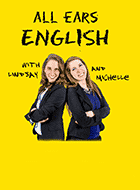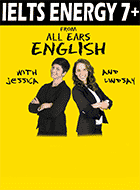Are you a good storyteller?
How many different grammar tenses does a storyteller use in one story?
Listen in to today’s episode for tips on telling engaging stories.
You’ll hear Aubrey and Lindsay’s stories and learn how to better tell your own!
Telling Stories
Aubrey asks Lindsay what verb tense she uses when telling a story.
Lindsay says she often uses the past tense.
She adds that she moves between the present tense, the past tense, and the present perfect tense.
It really depends on what happened when in the story.
Present tense comes up a lot because you’re trying to pull someone into the story, make them feel like they were there with you.
The key is to seamlessly move between different tenses.
In today’s episode, Lindsay and Aubrey are diving into the main verb tenses we use when telling a story.
The goal is to be able to tell interesting, engaging stories.
Structure of storytelling
When telling a story, you need to know what these different verb tenses are for so you know which to use.
Lindsay and Aubrey share a very brief overview of several tenses that you will use most often when telling a story.
They will go through the grammar for each and then Aubrey will use them all in a story about traveling in Nicaragua.
#1: Present perfect
This is often how we introduce a story.
It is used to set the stage and give the background of the story.
You can think of movies that have narration.
These are often in the present perfect tense.
Example:
“I’ve always loved finding new restaurants and last night…”
#2: Past simple
This is used to refer to finished actions in the past.
Often we start with the present perfect tense and then continue the story in the past simple tense.
We move to this tense to say something specific that happened in the past at a specific time.
Example:
Present perfect: “I’ve always loved finding new restaurants and last night…”
Past simple: “I ate at the best Thai restaurant.”
#3: Present
In order to pull people into the story, we often move to the present tense.
This helps the listener feel like they’re with you as the story unfolds.
Examples:
“We are in a parking lot and this woman arrives out of nowhere!”
“It’s 5:55 A.M., my alarm goes off…”
#4: Subjunctive
Subjunctive mood is used for hypotheticals.
It’s often interesting to add what could’ve been different if circumstances changed.
Example:
“Oh, if I hadn’t been there, this would never have happened.”
“If you were to read just one book this year, it should be this one!”
#5: Conditionals
We use the conditional verb tense when expressing that one thing is contingent on another.
It’s a great way to share what might happen or what might have happened.
We often start a sentence with the conditional and end with subjunctive mood.
Example:
“I would not have parked next to her if I’d have known that would happen!”
“We would’ve made a different choice if we’d known how it would all turn out.”
Be observant
You must pay attention and be observant when reading or listening to English.
When you hear someone else tell a story, notice all of the different verb tenses, so that you can make your stories more interesting.
We want you to be able to tell interesting stories.
It’s such a fun connection skill.
Story telling sample
Lindsay tells a story as an example.
She uses the different tenses mentioned in this episode.
This will show you how to tell a dynamic and interesting story.
Lindsay: So, Aubrey, I’ve always been an adventurous person, but I never imagined that I would do what I did on this day. So, I was in Nicaragua. I think I was in Managua or somewhere close to there. And after backpacking around for a couple of days, I realized, or we realized that the thing to do in Nicaragua, is volcano boarding. And not just volcano boarding, but active volcano boarding. So Nicaragua is a country with a lot of volcanoes, right? A lot of seismic activity. And so, we booked a tour to go volcano boarding. Have you ever heard of this before?
Aubrey: No.
Lindsay: Okay.
Aubrey: I have never heard of volcano boarding. I can’t believe that. I cannot wait to hear about this.
Lindsay: This is something that would be right up your alley. So, I saw videos of this, of what they actually do. What they do is they take the backs of refrigerators. Because the refrigerators are slick, right? They’re slippery. They take the back, that coating off the refrigerator, and they make it into a board.
And so what you do is you book a tour, you get up in the morning, super early, it’s still dark out. You hop on a bus, you drive for three hours. So we’re driving, and the terrain is getting more bumpy and more bumpy. We get there, we put these refrigerators. Not a full refrigerator, but it’s the, you know, our boards. We put them on our back. So we start hiking up this active volcano. And I’m always a little nervous about active volcanoes, right? Like, okay, let’s just hope that today’s not the day, you know, that this volcano explodes, right? Because that just wouldn’t be so convenient.
So we hike up this volcano, we get to the top. And I watch the guide, he does the example. He goes down and I’m terrified, Aubrey. I don’t think I’ve been that scared before in my life. I’m visibly shaking. I’m feeling my adrenaline is popping up, going throughout my body. And I’m thinking, “How the heck am I going to control my board?” Because this is a steep volcano, right? This is not an easy slope. And it doesn’t look like you have much control. All you do is you just slap it down, put your butt on it, and you go.
So I watch people go and they seem like they’re flying off and someone is getting their speed with a speed gun. And then it’s my turn. I’m one of the last ones to step up. And I’m thinking, “I don’t want to die on a volcano board,” This isn’t whereI want to go. And so I put it down and I sit down and I’’m supposed to use my feet as brakes. That was how it worked. And I realized, I had more control than I thought I did.
And so, I did go, but I ended up going really slow. Around 15 miles an hour down the volcano. And then at the end they had a list of speeds. And I think the fastest guy was 45 or 47 miles an hour. I was like 12. And it felt…
Aubrey: 45 miles an hour? That is insane!
Lindsay: Yeah. Wild. Wild. So, I was a little embarrassed…
Aubrey: Wow.
Lindsay: … about how slow I went but I was so happy to see that I could indeed control my speed and I wasn’t going to…
Aubrey: Yeah.
Lindsay: … die that day on that volcano, so.
Aubrey: This is crazy. I’ve never heard of anyone doing that before. I think it would be a hard pass on that.
Lindsay: Really?
Aubrey: And I feel like I’m an adventurous person. But, no, I don’t know.
Lindsay: But, Aubrey, you cliff jumped before. You’ve done way crazier things.
Aubrey: Well, that sounds so scary.
Lindsay: No? Yeah.
Aubrey: Maybe. If I were in that situation, I probably would be like, “I have got to try it.”
Which tenses were used?
Aubrey points out how Lindsay began with present perfect tense.
This set the scene.
She then moved to simple past.
To draw the listener in, she switches to present tense.
Aubrey points out that she also used continuous tense.
Takeaway
Native English speakers don’t stick to one verb tense.
They move in and out depending on what they are trying to convey.
Telling an interesting, engaging story is a vital connection skill.
Don’t worry about being perfect!
You can tell incredible, engaging stories while making some grammar mistakes.
Remember, Connection NOT Perfection™
You can also check out episode AEE 2401: How to Be a More Interesting Storyteller.
This episode will give you more tips on being a good storyteller.
What is an interesting story you can share with us?
We’d love to hear from you in the comments below.



